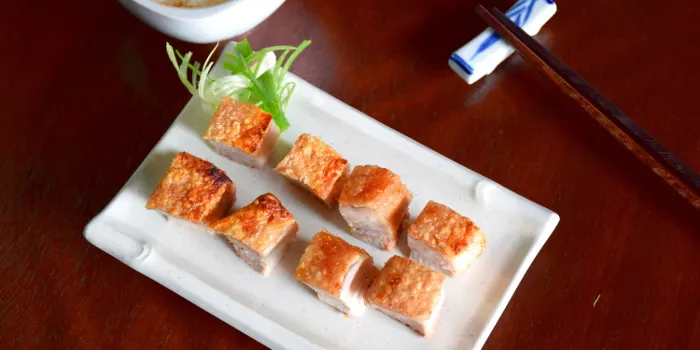Roast pork belly is the classic Cantonese recipe that will satisfy even the most critical connoisseur. Chinese roast pork is famous for its crackling skin and aromatic meat.
Chinese roast pork belly is so popular in Asia that chefs specialize in roasting pork in restaurants. However, it is already a daunting task to roast pork on the barbecue pit, not to mention to cook the whole pork belly over an open fire as in the Chinese restaurant.
Note: This post may contain affiliate links. Please read my privacy policy for more info. I may receive commissions for purchases made through links in this post. As an Amazon Associate, I earn from qualifying purchases.

Chinese roast pork belly with oven
I want to introduce a much simpler way to do it with just the oven. It is hassle-free and easy to replicate. Although oven-baked is not the method used in restaurants, the result is comparable to any roast pork belly from the Chinese restaurant.
The allure of roast crispy pork belly lies in its simplicity. You only need several ingredients and follow a few steps, and the result is almost guaranteed and fail-proof. The crackling sound of biting into the crispy skin fresh from the oven is sufficient to make you drool nonstop.
The oven will do the bulk of the work. And best of all, most of the work is passive cooking. You can marinate the pork, leave it in the fridge overnight, and then roast it in the oven to toast. After all, you will be rewarded with the irresistible aroma of the roast pork belly, enjoy the crackling, firecracker-like music as you slice the meat and eat it.
Note: The Chinese roast pork belly is called 烧肉 in Chinese, translated into English as siew yoke, siew yuk, or siu yuk, which means the same thing.
Step-by-step guide- How to make the Cantonese style crispy roast pork
1. Use pork belly to make siu yuk
Choose the right cut of meat
The best part of the pork for making roast pork is the belly. The pork belly has plenty of fat with layers of lean meat in between, which is ideal for roasting.
You can request your butcher to cut the pork belly to a square or rectangle for you, making it easier to handle.
Always leave the skin on the pork belly. This skin is the best part of the roast pork, which is crispy and crackling.
Blanch the pork
Bring a pot of shallow water to a boil, which is enough to submerge at least half of the pork belly. Blanch the pork belly in water for 10 minutes, skin side down.
There are two purposes of this step:
- It softens the skin so that it is easier to prick holes on it in the following step. It is difficult the poke through the skin before blanching.
- The meat absorbs the water and will not dry out after roasting.
- It removes the undesirable meaty smell.
After blanching, remove the pork and let it cools. The pork’s skin will shrink slightly after blanching, and the meat may bulge out a little at the side. You can trim off the uneven sides to make it nice looking. Keep the trim off parts for other dishes such as stir-frying.
Check the skin whether there are still any hairs. Scrape the skin with a knife to remove any dirt and remaining hairs.
2. Prick plenty of holes on the skin
Now it comes to the critical part to create crispy skin- prick holes on the skin.
There are s few reasons why you need to prick multiples small hole on the skin:
- Skin with small holes helps the skin to pop, forming small blisters and become crispy. It helps to let the fat render out onto the skin.
- After pricking, the air will escape from the holes to prevent the skin from bulging. This step effectively prevents the skin from separating from the meat during roasting, which will detach from the meat when you cut it into small pieces.
Note:
- There is no undesirable consequence of pricking too many holes on the skin. On the contrary, too few holes will not produce crispy skin. I keep poking the skin with my small fork non-stop for five minutes for the pork I use in the video to give you an idea. (about 800g).
- The goal is to make holes in the skin but not penetrate the fat down to the first lean layer. Otherwise, the juice will exude from the meat beneath during roasting, drench the skin to become wet and unable to form a crackling layer.
You can prick the holes with a small fork or a meat mallet (those with many sharp needles.)

3. Marinade the meat
- Make a few shallow cuts on the flesh side of the pork.
- Rub the marinade into each cut to let it penetrate the interior of the meat. The cuts should be about halfway through the meat.
- The seasoning ingredients for the Cantonese-style roast pork are salt, sugar, ground white pepper, Chinese five-spice powder, Shaoxing wine, and hoisin sauce. This combination is not a fixed formula, as you can omit the hoisin sauce if you prefer.
- Combine the seasoning in a small bowl, then massage it all over the meat, particularly between the cuts.
- Keep the skin clean from the marinade, as it can burn quickly during roasting.
4. Keep the skin as dry as possible
The most crucial step to make the skin crispy is to keep it as dry as possible. I use a few techniques to make it very dry.
a. Use vinegar and baking soda
Mix one tablespoons of white vinegar with a half teaspoon of baking soda in a small bowl. Apply a thin layer of the mixture on the skin.
Note: Baking soda helps make the skin crispy by allowing the proteins to break down and promote crisper and more evenly browning. The air (carbon dioxide) that releases reacts with the moisture, forming tiny bubbles that increase the surface area and create crispier skin. The vinegar helps to draw out the water and neutralize the baking soda.
b. Apply some salt
Sprinkle half a teaspoon of salt on the skin just before it goes in the oven. It will cause more water leeches out of the skin.
I used to make the roast pork by placing a thick layer of sea salt on the skin, forming a salt crust that draws out the excess water to make it crispy. However, I cannot reuse the salt, and it is quite wasteful. I can achieve the same result with less salt with the combination of vinegar and baking soda.
c. Keep the pork in the fridge overnight
There are two reasons to keep the pork in the fridge for at least 4 hours (better if overnight). There is enough time for the marinade to penetrate the pork’s interior so that it becomes flavorful. Secondly, the surface of the skin is dry enough to produce crispy skin.
Keep the pork uncovered and chill for at least half a day. Some roast pork belly recipes suggest chilling the pork overnight or even up to two days. The skin’s surface will become very dry (feel like leather), and the flavor will have enough time to penetrate the inner part of the pork.
If you prefer the conventional method, dry the pork by hanging it upright with a hook and place it in front of a fan for a few hours. Air dry is the preferred method to make a large batch of siu yuk.
I remove the pork belly from the refrigerator until it returns to room temperature before putting it into the oven. Otherwise, the interior of the pork may not fully cooked when the skin has turned crispy.
5. Roast the pork belly
I do not wrap the pork with aluminum foil which turns out to be equally good. Since I roast it at 150°C/300°F for the first 1.5 hours and only increase the top heat to broil it subsequently, the pork belly is still tender and moist.
Here are the steps :
- The next day, remove the pork belly from the refrigerator at least one hour before roasting so that the pork returns to room temperature.
- Apply half a teaspoon of salt on the skin. Spread it evenly on the surface. You will see plenty of water on the skin due to the condensation at room temperature and salt’s effect to draw more water from the skin.
- Wipe off the water with a paper towel to keep it dry.
- When it returns to room temperature, apply a thin layer of oil on the skin.
- Roast the pork on a medium rack for 1.5 hours at 150°C/300°F.
- Now place the pork on the top rack. Change the oven setting to 250°C/480°C, top heat and 150°C/300°F bottom heat for forty minutes (depends on the oven).
- You can extend the roasting time until the skin has turned to golden brown with multiple blisters.
Note: The highest temperature of my small oven is only up to 230°C/445°F. It is not hot enough to effectively erupt the skin to create a crackling texture. As a result, I reverse a metal plate and put it on the highest rack to closer the heating element.
Other related recipes to the roast pork belly recipe.
Note: If you like roast pork belly, you will also be interested in trying other related recipes:
Braised pork belly with taro is a favorite home-cooked dish among the Hakka clan. This dish is exceptional. Why? Because the pork belly is served up-ended, Check it out.
Braised pork belly or Dong Po Rou (东坡肉) is an iconic traditional Chinese braised pork belly recipe. The prolonged stewing with wine breaks down the fat to make the braised pork belly flavorsome, succulent and give it the tender “melt-in-the-mouth” texture.
An interesting news
After analyzing more than 1,000 raw foods, researchers ranked the ingredients that provide the best balance of your daily nutritional requirements – and they found a few surprises.
According to a report by BBC published on 29 January 2018, pork fat is a good source of B vitamins and minerals. Pork fat is more unsaturated and healthier than lamb or beef fat.
Rich in oleic acid and monosaturated fat, it is beneficial to our heart, artery, and skin.
Sources: World of Buzz and BBC

Roast pork recipe- Chinese style (烧肉/ siew yoke)
This video will show you how to make Chinese roast pork at home. Chinese roast pork is famous for its crackling skin and aromatic meat.
Ingredients
Marinade
- 750 g pork belly
- 10g salt
- 15g sugar
- 1/2 tsp ground white pepper
- 1 tsp Chinese five-spice powder
- 1 tbsp Shaoxing wine
- 1 tsp hoisin sauce (optional)
Others
- 1 tbsp white vinegar
- 1/2 tsp baking soda
- 2 tsp oil
Instructions
- Bring a pot of shallow water to a boil. Blanch the pork belly in water for 10 minutes, skin side down. After blanching, remove the pork and let it cools.
- Scrape the skin with a knife to remove any dirt and remaining hairs.
- Prick multiples small hole on the skin with a small fork.
- Make a few shallow cuts on the flesh side of the pork, halfway through the meat.
- Mix all the marinade ingredients. Combine the seasoning in a small bowl, then massage it all over the meat, particularly between the cuts.
- Keep the skin clean from the marinade.
- Mix one tablespoons of white vinegar with a half teaspoon of baking soda in a small bowl. Apply a thin layer of the mixture on the skin.
- Keep the pork in the fridge overnight.
- Remove the pork belly from the refrigerator at least one hour before roasting so that the pork returns to room temperature.
- Sprinkle half a teaspoon of salt on the skin just before it goes in the oven. Wipe off the excess moisture.
- Apply a thin layer of oil on the skin. Roast the pork on a medium rack for 1.5 hours at 150°C.
- Now place the pork on the top rack. Change the oven setting to 230°C, top heat only for thirty minutes, or until the skin has turned to golden brown with multiple blisters.
Recommended Products
As an Amazon Associate and member of other affiliate programs, I earn from qualifying purchases.
Nutrition Information:
Yield: 3 Serving Size: 1Amount Per Serving: Calories: 789Total Fat: 57gSaturated Fat: 20gTrans Fat: 0gUnsaturated Fat: 35gCholesterol: 210mgSodium: 1766mgCarbohydrates: 7gFiber: 0gSugar: 5gProtein: 58g
This data was provided and calculated by Nutritionix on 3/10/2021





Roast Pork with Gai Lan: A Quick and Easy Stir-Fry
Thursday 19th of June 2025
[…] If you prefer to make your Chinese roast pork at home, I’ve uploaded both a video and the full recipe on my food blog. Please check out the Roast Pork video and the Roast Pork recipe. […]
C
Sunday 2nd of October 2022
Thanks for the recipe, it turned out great! Slightly burned it after only 15 minutes at the higher temperature (low broil) even though I kept it at least a few inches from the top heating element. Note: must watch the skins very closely bec/ they'll go from crisping to burning fairly quickly.
All the same, 1.5hours at 300F thoroughly cooked the belly pork and it was still juicy, while the skin was light and crisp. The fat rendered nicely into the glass baking dish and I will keep it for other cooking.
We have a few Chinese grocery stores here, but not a vendor that sells roast duck/pork (restaurants may serve it but are just so-so). Been craving crispy pork for a while now, and this will be my go-to.
KP Kwan
Monday 3rd of October 2022
Thanks for sharing your experience :)
Connie
Tuesday 21st of June 2022
I've tried several other crispy pork belly recipes. I like this one for the initial blanching and how it makes the skin more manageable or more easily punctured by a normal fork. (The last thing I need is yet another specialized kitchen tool.) Roasting low and slow helped keep the cut moist, and in the course of this recipe I figured out hot to use the top element (broil, low) on my oven properly.
Long story short: the skin bubbled and crisped up nicely but I underseasoned the meat, even with the shallow cuts. This was more than compensated by an ad hoc dip (oyster sauce or sweet mustard).
Thank you for this recipe. It was easy to follow. We all have to learn to use our kitchens well!
Elaine Leong
Wednesday 10th of March 2021
Hi, My oven has only the top heating element and with the fan function. It has 3 levels in the oven with Max 220 deg. For this roasted pork recipe , at which level and temp setting should I place the pork for the initial 1.5 hr and also the final stage of the 30 mins.? Shall I use the fan function during roasting? Looking forward to your response. Thanks
KP Kwan
Wednesday 10th of March 2021
Hi Elaine, My biggest problem is to get the skin to erupt with multiple blisters at the final stage. Mine is maxed at 230°C, and I could not make it crackle until I raise the pork close to the top element by putting a plate on the top rack so that the pork was just about 1 inch from the element! I suggest you switch on the fan throughout so that the temperature is more even since there is only one heating element. Try to put it on the top rack throughout, and I think it should be fine for the initial low temperature. If you can't get the crackling after the last 30 minutes, try to roast it longer and find ways to keep the pork close to the heating element to get the maximum heat. Good luck, and I hope it works :) KP Kwan
Joni Wong
Monday 22nd of February 2021
Thanks for your reply. Am trying it again today. The first time I did, I put it on middle (3rd) rack n broil on lowest rack as I have yet to hear from u when started roasting. Let's see what happens today. Thanks for your easy to folo recipes with precise instructions n explanations.